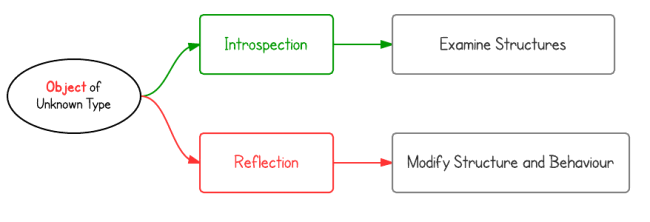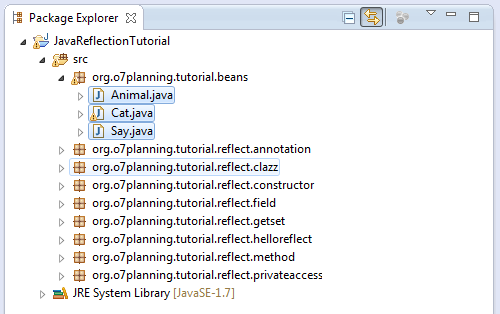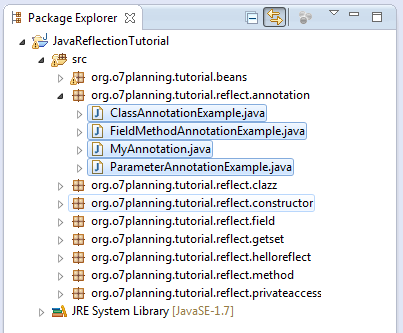Die Anleitung zu Java Reflection
1. Was ist Java Reflection ?
Java benutzt"Java Reflection"für die Namenstellung für ein wictiges API wie in der Standardbibliothek von Java. Warum wird API so genannt? Analysieren Sie
Reflection ist ein Reflektionsbild für ein Objekt. Zum Beispiel das Bild von Ihnen in einem Spiegel oder ein Reflektiertes Bild eines Baum am See. Das Wort"Java Reflection" weist einfach ein anderes Bild an, ein anderer Zugang von Java.

Java ist eine objektorientierte Sprache (Object-oriented), normalerweise sollen Sie ein Objekt erstellen und Sie können durch den Operator Punkt (.) in die Felder (field) zugreifen oder die Methode (method) des Objekt aufrufen
Java Reflection stellt einen anderen Zugang vor. Sie können in einem Feld des Objekt zugrefien wenn Sie den Name des Feldes kennen. Oder Sie können eine Methode des Objekt aufrufen wenn Sie den Name der Methode, die Parameterstyüem der Methode und die Wert zur Zuweisung kennen
Java Reflecion erlaubt Sie die Struktur und Verhalten eines Objekt bei runtime des Programm zu bewerte un ändern. Gleichzeitig erlaubt sie Sie bei dem ZUgang in der Mitglieder private (private member) irgendwo in der Applikation. Das funktioniert mit dem traditionallen Zugang nicht

- Java kann normalerweise Java Introspection genannt. Das Programm kann die Struktur eines Objekt bei runtime bewerten.
- Mit Java Reflection kann das Programm die Struktur eines Objekt bei runtime bewerten, die Struktur und Verhalten des Objekt ändern
2. Einige Klasse zur Teilnahme an die Beispiele
Das sind die Class zur Teilname an den Beispiele im Dokument

Animal.java
package org.o7planning.tutorial.beans;
public abstract class Animal {
public String getLocation() {
return "Earth";
}
public abstract int getNumberOfLegs() ;
}Say.java
package org.o7planning.tutorial.beans;
public interface Say {
public String say();
}Cat.java
package org.o7planning.tutorial.beans;
public class Cat extends Animal implements Say {
public static final String SAY = "Meo meo";
public static final int NUMBER_OF_LEGS = 4;
// Private field.
private String name;
// Private field
public int age;
public Cat() {
}
public Cat(String name) {
this.name = name;
this.age = 1;
}
public Cat(String name, int age) {
this.name = name;
this.age = age;
}
public String getName() {
return this.name;
}
// Private Method.
private void setName(String name) {
this.name = name;
}
public int getAge() {
return this.age;
}
public void setAge(int age) {
this.age = age;
}
/**
* Implements from interface Say.
*/
@Override
public String say() {
return SAY;
}
/**
* Implements from Animal.
*/
@Override
public int getNumberOfLegs() {
return NUMBER_OF_LEGS;
}
}3. Beginnen wir mit einem einfachen Beispiel
Das ist ein einfaches Beispiel: Die Liste von der public Method einer Class abrufen, einschließlich die Inheritance Method aus der Superclass und die Interface.
ListMethod.java
package org.o7planning.tutorial.reflect.helloreflect;
import java.lang.reflect.Method;
public class ListMethod {
// Protected method
protected void info() {
}
public static void testMethod1() {
}
public void testMethod2() {
}
public static void main(String[] args) {
// Get a list of public methods of this class
// Include methods inherited from the parent class, or interface.
// Lấy ra danh sách các method public của class này
// Bao gồm các các method thừa kế từ class cha, hoặc các interface.
Method[] methods = ListMethod.class.getMethods();
for (Method method : methods) {
System.out.println("Method " + method.getName());
}
}
}Running example:
Method testMethod1
Method testMethod2
Method main
Method wait
Method wait
Method wait
Method equals
Method toString
Method hashCode
Method getClass
Method notify
Method notifyAll4. Class
Einige wictigen Methode in Reflection beziehen auf die Class.
Beispiel von der Schreiben der Grundinformation der Class wie Name der class, package, modifier , ..
ShowClassInfo.java
package org.o7planning.tutorial.reflect.clazz;
import java.lang.reflect.Modifier;
public final class ShowClassInfo {
public static void main(String[] args) {
// Get Class object represent ShowClassInfo class.
Class<ShowClassInfo> aClass = ShowClassInfo.class;
// Print out class name, including the package name.
System.out.println("Class Name= " + aClass.getName());
// Print out simple class name (without package name).
System.out.println("Simple Class Name= " + aClass.getSimpleName());
// Package info
Package pkg = aClass.getPackage();
System.out.println("Package Name = " + pkg.getName());
// Modifier
int modifiers = aClass.getModifiers();
boolean isPublic = Modifier.isPublic(modifiers);
boolean isInterface = Modifier.isInterface(modifiers);
boolean isAbstract = Modifier.isAbstract(modifiers);
boolean isFinal = Modifier.isFinal(modifiers);
// true
System.out.println("Is Public? " + isPublic);
// true
System.out.println("Is Final? " + isFinal);
// false
System.out.println("Is Interface? " + isInterface);
// false
System.out.println("Is Abstract? " + isAbstract);
}
}Das Ergebni vom Starten der Class:
Class Name= org.o7planning.tutorial.reflect.clazz.ShowClassInfo
Simple Class Name= ShowClassInfo
Package Name = org.o7planning.tutorial.reflect.clazz
Is Public? true
Is Final? true
Is Interface? false
Is Abstract? falseDas Beispiel vom Aufschreiben der Class Cat, wie Name der Class und der Interface, die diese Class durchführt
ShowClassCatInfo.java
package org.o7planning.tutorial.reflect.clazz;
import org.o7planning.tutorial.beans.Cat;
public class ShowClassCatInfo {
public static void main(String[] args) {
// The Class object represent Cat class
Class<Cat> aClass = Cat.class;
// Class name
System.out.println("Simple Class Name = " + aClass.getSimpleName());
// Get the Class object represent parent of Cat class
Class<?> aSuperClass = aClass.getSuperclass();
System.out.println("Simple Class Name of Super class = "
+ aSuperClass.getSimpleName());
// Determines the interfaces implemented by the class
// or interface represented by this object.
Class<?>[] itfClasses = aClass.getInterfaces();
for (Class<?> itfClass : itfClasses) {
System.out.println("Interface: " + itfClass.getSimpleName());
}
}
}Das Ergebni vom Starten der Class:
Simple Class Name = Cat
Simple Class Name of Super class = Animal
Interface: SayDas Beispiel von dem Abrufen der Information von Constructor, Method, field der class (nur public), einschließlich die publich method, public field, Inheritance von der superclass und die Interface.
ShowMemberInfo.java
package org.o7planning.tutorial.reflect.clazz;
import java.lang.reflect.Constructor;
import java.lang.reflect.Field;
import java.lang.reflect.Method;
import org.o7planning.tutorial.beans.Cat;
public class ShowMemberInfo {
public static void main(String[] args) {
// Get object represent Cat class.
Class<Cat> aClass = Cat.class;
// Get Constructor array of Cat.
Constructor<?>[] constructors = aClass.getConstructors();
System.out.println(" ==== CONSTRUCTORs: ===== ");
for (Constructor<?> constructor : constructors) {
System.out.println("Constructor: " + constructor.getName());
}
// Get a list of public method of Cat
// Include the methods inherited from the parent class and the interfaces
Method[] methods = aClass.getMethods();
System.out.println(" ==== METHODs: ====== ");
for (Method method : methods) {
System.out.println("Method: " + method.getName());
}
// Get the list of the public fields
// Include the fields inherited from the parent class, and the interfaces
Field[] fields = aClass.getFields();
System.out.println(" ==== FIELDs: ====== ");
for (Field field : fields) {
System.out.println("Field: " + field.getName());
}
}
}Das Ergebnis
==== CONSTRUCTORs: =====
Constructor: org.o7planning.tutorial.beans.Cat
Constructor: org.o7planning.tutorial.beans.Cat
Constructor: org.o7planning.tutorial.beans.Cat
==== METHODs: ======
Method: getAge
Method: setAge
Method: say
Method: getNumberOfLegs
Method: getName
Method: getLocation
Method: wait
Method: wait
Method: wait
Method: equals
Method: toString
Method: hashCode
Method: getClass
Method: notify
Method: notifyAll
==== FIELDs: ======
Field: SAY
Field: NUMBER_OF_LEGS
Field: age5. Constructor
Das Beispiel von der Abrufen einer Constructor mit dem bestimmten Parameter. Und die Information dieser Constructor aufschreiben.
ConstructorExample.java
package org.o7planning.tutorial.reflect.constructor;
import java.lang.reflect.Constructor;
import java.lang.reflect.InvocationTargetException;
import org.o7planning.tutorial.beans.Cat;
public class ConstructorExample {
public static void main(String[] args) throws NoSuchMethodException,
SecurityException, InstantiationException, IllegalAccessException,
IllegalArgumentException, InvocationTargetException {
// Get Class object represent Cat class.
Class<Cat> aClass = Cat.class;
// Get the Constructor object of the public constructor
// that matches the specified parameterTypes
Constructor<?> constructor = aClass.getConstructor(String.class,
int.class);
// Get parameter array of this constructor.
Class<?>[] paramClasses = constructor.getParameterTypes();
for (Class<?> paramClass : paramClasses) {
System.out.println("Param: " + paramClass.getSimpleName());
}
// Initialize the object in the usual way
Cat tom = new Cat("Tom", 3);
System.out
.println("Cat 1: " + tom.getName() + ", age =" + tom.getAge());
// Using Java reflection to create object
Cat tom2 = (Cat) constructor.newInstance("Tom", 2);
System.out.println("Cat 2: " + tom.getName() + ", age ="
+ tom2.getAge());
}
}Das Ergebnis vom Starten der Class:
Param: String
Param: int
Cat 1: Tom, age =3
Cat 2: Tom, age =26. Field
Das Beispiel von dem Abrufen der field mit einem bestimmten Name.
FieldExample.java
package org.o7planning.tutorial.reflect.field;
import java.lang.reflect.Field;
import org.o7planning.tutorial.beans.Cat;
public class FieldExample {
public static void main(String[] args) throws NoSuchFieldException,
SecurityException, IllegalArgumentException, IllegalAccessException {
// Get Class object represent Cat class
Class<Cat> aClass = Cat.class;
// Get Field object represent field 'NUMBER_OF_LEGS'.
Field field = aClass.getField("NUMBER_OF_LEGS");
Class<?> fieldType = field.getType();
System.out.println("Field type: " + fieldType.getSimpleName());
Field ageField = aClass.getField("age");
Cat tom = new Cat("Tom", 5);
// Returns the value of the field represented by this Field,
// on the specified object.
Integer age = (Integer) ageField.get(tom);
System.out.println("Age = " + age);
// Sets the field represented by this Field object on
// the specified object argument to the specified new value.
ageField.set(tom, 7);
System.out.println("New Age = "+ tom.getAge());
}
}Das Ergebnis vom Starten der Class
Field type: int
Age = 5
New Age = 77. Method
Das Beispiel von dem Abrufen einer Method durch einen Name und den vorher bestimmten Parameter. Aufschreiben der Information über die Method , Liste von Parameter ...
MethodExample.java
package org.o7planning.tutorial.reflect.method;
import java.lang.reflect.InvocationTargetException;
import java.lang.reflect.Method;
import org.o7planning.tutorial.beans.Cat;
public class MethodExample {
public static void main(String[] args) throws NoSuchMethodException,
SecurityException, IllegalAccessException,
IllegalArgumentException, InvocationTargetException {
// Class object represent Cat class
Class<Cat> aClass = Cat.class;
// Method object represent getAge() method.
Method getAgeMethod = aClass.getMethod("getAge");
// return type of method.
Class<?> returnType= getAgeMethod.getReturnType();
System.out.println("Return type of getAge: "+ returnType.getSimpleName());
Cat tom = new Cat("Tom", 7);
// Call method 'getAge' way Reflect
// This is equivalent to calling: tom.getAge()
int age = (int) getAgeMethod.invoke(tom);
System.out.println("Age = " + age);
// Method object represent setAge(int) method of Cat class.
Method setAgeMethod = aClass.getMethod("setAge", int.class);
// Call method setAge(int) way Reflect
// This is equivalent to calling: tom.setAge(5)
setAgeMethod.invoke(tom, 5);
System.out.println("New Age = " + tom.getAge());
}
}Das Ergebnis vom Starten der Class
Return type of getAge: int
Age = 7
New Age = 58. Die Methode getter und setter
No ADS
Das unten Beispiel: die Public setter method und die Public getter method von der Class listen
GetSetExample.java
package org.o7planning.tutorial.reflect.getset;
import java.lang.reflect.Method;
import org.o7planning.tutorial.beans.Cat;
public class GetSetExample {
// Method is getter if names start with get, and no parameters.
public static boolean isGetter(Method method) {
if (!method.getName().startsWith("get")) {
return false;
}
if (method.getParameterTypes().length != 0) {
return false;
}
if (void.class.equals(method.getReturnType())) {
return false;
}
return true;
}
// Method is setter if names start with set, and only one parameter.
public static boolean isSetter(Method method) {
if (!method.getName().startsWith("set")) {
return false;
}
if (method.getParameterTypes().length != 1) {
return false;
}
return true;
}
public static void main(String[] args) {
// Class object represet Cat class
Class<Cat> aClass = Cat.class;
// public methods
Method[] methods = aClass.getMethods();
for (Method method : methods) {
boolean isSetter = isSetter(method);
boolean isGetter = isGetter(method);
System.out.println("Method: " + method.getName());
System.out.println(" - Is Setter? " + isSetter);
System.out.println(" - Is Getter? " + isGetter);
}
}
}Das Ergebnis vom Starten des Programms:
Method: getName
- Is Setter? false
- Is Getter? true
Method: getNumberOfLegs
- Is Setter? false
- Is Getter? true
Method: getAge
- Is Setter? false
- Is Getter? true
Method: setAge
- Is Setter? true
- Is Getter? false
Method: say
- Is Setter? false
- Is Getter? false
Method: getLocation
- Is Setter? false
- Is Getter? true
Method: wait
- Is Setter? false
- Is Getter? false
Method: wait
- Is Setter? false
- Is Getter? false
Method: wait
- Is Setter? false
- Is Getter? false
Method: equals
- Is Setter? false
- Is Getter? false
Method: toString
- Is Setter? false
- Is Getter? false
Method: hashCode
- Is Setter? false
- Is Getter? false
Method: getClass
- Is Setter? false
- Is Getter? true
Method: notify
- Is Setter? false
- Is Getter? false
Method: notifyAll
- Is Setter? false
- Is Getter? false9. In private method, field zugreifen
No ADS
Sie können die private method oder field nicht zugreifen. Der Compiler vom Java genehmigt auch nicht. Aber es klingt mit Java Reflection
AccessPrivateFieldExample.java
package org.o7planning.tutorial.reflect.privateaccess;
import java.lang.reflect.Field;
import org.o7planning.tutorial.beans.Cat;
public class AccessPrivateFieldExample {
public static void main(String[] args) throws IllegalArgumentException,
IllegalAccessException, NoSuchFieldException, SecurityException {
// Class object represent Cat class
Class<Cat> aClass = Cat.class;
// Class.getField(String) get public field only.
// Use Class.getDeclaredField(String):
// Get the Field object of field declared in class.
Field private_nameField = aClass.getDeclaredField("name");
// Allows for access to private field.
// Avoid IllegalAccessException
private_nameField.setAccessible(true);
Cat tom = new Cat("Tom");
String fieldValue = (String) private_nameField.get(tom);
System.out.println("Value field name = " + fieldValue);
// Set new valud for 'name' field.
private_nameField.set(tom, "Tom Cat");
System.out.println("New name = " + tom.getName());
}
}Das Ergebni vom Starten der Class:
Value field name = Tom
New name = Tom CatDas nächste Beispiel: Zugang zur privaten Method.
AccessPrivateMethodExample.java
package org.o7planning.tutorial.reflect.privateaccess;
import java.lang.reflect.InvocationTargetException;
import java.lang.reflect.Method;
import org.o7planning.tutorial.beans.Cat;
public class AccessPrivateMethodExample {
public static void main(String[] args) throws NoSuchMethodException,
SecurityException, IllegalAccessException,
IllegalArgumentException, InvocationTargetException {
// Class object represent Cat class.
Class<Cat> aClass = Cat.class;
// Class.getMethod(String) get public method only.
// Use Class.getDeclaredMethod(String):
// Get the Method object of method declared in class.
Method private_setNameMethod = aClass.getDeclaredMethod("setName",
String.class);
// Allows for access to private method.
// Avoid IllegalAccessException
private_setNameMethod.setAccessible(true);
Cat tom = new Cat("Tom");
// Call private method
private_setNameMethod.invoke(tom, "Tom Cat");
System.out.println("New name = " + tom.getName());
}
}Das Ergebnis
New name = Tom Cat10. Annotation
No ADS

MyAnnotation.java
package org.o7planning.tutorial.reflect.annotation;
import java.lang.annotation.ElementType;
import java.lang.annotation.Retention;
import java.lang.annotation.RetentionPolicy;
import java.lang.annotation.Target;
// Annotation can be used at runtime.
@Retention(RetentionPolicy.RUNTIME)
// Use for class, interface, method, field, parameter.
@Target({ ElementType.TYPE, ElementType.METHOD, ElementType.FIELD,
ElementType.PARAMETER })
public @interface MyAnnotation {
String name();
String value() default "";
}Ein Beispiel von Annotation mit der class:
ClassAnnotationExample.java
package org.o7planning.tutorial.reflect.annotation;
import java.lang.annotation.Annotation;
@MyAnnotation(name = "Table", value = "Employee")
public class ClassAnnotationExample {
public static void main(String[] args) {
Class<?> aClass = ClassAnnotationExample.class;
// Get array of the Annotation of class
Annotation[] annotations = aClass.getAnnotations();
for (Annotation ann : annotations) {
System.out.println("Annotation: " + ann.annotationType().getSimpleName());
}
// Or More specific
Annotation ann = aClass.getAnnotation(MyAnnotation.class);
MyAnnotation myAnn = (MyAnnotation) ann;
System.out.println("Name = " + myAnn.name());
System.out.println("Value = " + myAnn.value());
}
}Das Ergebnis
Annotation: MyAnnotation
Name = Table
Value = EmployeeEin Beispiel von Annotaion mit Field & Method:
FieldMethodAnnotationExample.java
package org.o7planning.tutorial.reflect.annotation;
import java.lang.annotation.Annotation;
import java.lang.reflect.Field;
import java.lang.reflect.Method;
public class FieldMethodAnnotationExample {
@MyAnnotation(name = "My Field")
private int myField;
@MyAnnotation(name = "My Method", value = "My Method Value")
protected void myMethod(String str) {
}
public static void main(String[] args) throws NoSuchFieldException,
SecurityException, NoSuchMethodException {
Class<?> aClass = FieldMethodAnnotationExample.class;
//
System.out.println(" == FIELD == ");
Field field = aClass.getDeclaredField("myField");
// Get array of Annotation of field
Annotation[] fieldAnns = field.getAnnotations();
for (Annotation methodAnn : fieldAnns) {
System.out.println("Annotation: "
+ methodAnn.annotationType().getSimpleName());
}
// Or more specific
Annotation fieldAnn = field.getAnnotation(MyAnnotation.class);
MyAnnotation myAnn1 = (MyAnnotation) fieldAnn;
System.out.println("Name = " + myAnn1.name());
System.out.println("Value = " + myAnn1.value());
// Similar for method ...
System.out.println(" == METHOD == ");
Method method = aClass.getDeclaredMethod("myMethod", String.class);
// Get array of Annotation of method
Annotation[] methodAnns = method.getAnnotations();
for (Annotation methodAnn : methodAnns) {
System.out.println("Annotation: "
+ methodAnn.annotationType().getSimpleName());
}
// For more specific
Annotation methodAnn = method.getAnnotation(MyAnnotation.class);
MyAnnotation myAnn2 = (MyAnnotation) methodAnn;
System.out.println("Name = " + myAnn2.name());
System.out.println("Value = " + myAnn2.value());
}
}Das Ergebnis
== FIELD ==
Annotation: MyAnnotation
Name = My Field
Value =
== METHOD ==
Annotation: MyAnnotation
Name = My Method
Value = My Method ValueDas Beispiel von Annotaion mit dem Parameter von der Methode:
ParameterAnnotationExample.java
package org.o7planning.tutorial.reflect.annotation;
import java.lang.annotation.Annotation;
import java.lang.reflect.Method;
public class ParameterAnnotationExample {
// For example, a method with annotations in parameters.
protected void doSomething(int jobType,
@MyAnnotation(name = "Table", value = "Employee") String info) {
}
public static void main(String[] args) throws NoSuchMethodException,
SecurityException {
Class<?> aClass = ParameterAnnotationExample.class;
// Get Method object of doSomething(int,String) method.
Method method = aClass.getDeclaredMethod("doSomething", int.class,
String.class);
// Get parameters list of method
Class<?>[] parameterTypes = method.getParameterTypes();
for (Class<?> parameterType : parameterTypes) {
System.out.println("Parametete Type: "
+ parameterType.getSimpleName());
}
System.out.println(" ---- ");
// Returns an array of arrays of Annotations that
// represent the annotations on the formal parameters
Annotation[][] annotationss = method.getParameterAnnotations();
// Get Annotation list of parameter index 1.
Annotation[] annotations = annotationss[1];
for (Annotation ann : annotations) {
System.out.println("Annotation: "
+ ann.annotationType().getSimpleName());
}
}
}Parametete Type: int
Parametete Type: String
----
Annotation: MyAnnotationNo ADS
Java Grundlagen
- Anpassen von Java-Compiler, der Ihre Annotation verarbeitet (Annotation Processing Tool)
- Java Programmierung für Team mit Eclipse und SVN
- Die Anleitung zu Java WeakReference
- Die Anleitung zu Java PhantomReference
- Komprimierung und Dekomprimierung in Java
- Konfigurieren von Eclipse zur Verwendung des JDK anstelle von JRE
- Java-Methoden String.format() und printf()
- Syntax und neue Funktionen in Java 8
- Die Anleitung zu Java Reguläre Ausdrücke
- Die Anleitung zu Java Multithreading Programming
- JDBC Driver Bibliotheken für verschiedene Arten von Datenbank in Java
- Die Anleitung zu Java JDBC
- Holen Sie sich die automatisch erhöhenden Wert der Spalte bei dem Insert eines Rekord, der JDBC benutzt
- Die Anleitung zu Java Stream
- Die Anleitung zu Java Functional Interface
- Einführung in Raspberry Pi
- Die Anleitung zu Java Predicate
- Abstrakte Klasse und Interface in Java
- Zugriffsmodifikatoren (Access modifiers) in Java
- Die Anleitung zu Java Enum
- Die Anleitung zu Java Annotation
- Vergleichen und Sortieren in Java
- Die Anleitung zu Java String, StringBuffer und StringBuilder
- Die Anleitung zu Java Exception
- Die Anleitung zu Java Generics
- Manipulieren von Dateien und Verzeichnissen in Java
- Die Anleitung zu Java BiPredicate
- Die Anleitung zu Java Consumer
- Die Anleitung zu Java BiConsumer
- Was ist erforderlich, um mit Java zu beginnen?
- Geschichte von Java und der Unterschied zwischen Oracle JDK und OpenJDK
- Installieren Sie Java unter Windows
- Installieren Sie Java unter Ubuntu
- Installieren Sie OpenJDK unter Ubuntu
- Installieren Sie Eclipse
- Installieren Sie Eclipse unter Ubuntu
- Schnelle lernen Java für Anfänger
- Geschichte von Bits und Bytes in der Informatik
- Datentypen in Java
- Bitweise Operationen
- if else Anweisung in Java
- Switch Anweisung in Java
- Schleifen in Java
- Die Anleitung zu Java Array
- JDK Javadoc im CHM-Format
- Vererbung und Polymorphismus in Java
- Die Anleitung zu Java Function
- Die Anleitung zu Java BiFunction
- Beispiel für Java Encoding und Decoding mit Apache Base64
- Die Anleitung zu Java Reflection
- Java-Remote-Methodenaufruf - Java RMI
- Die Anleitung zu Java Socket
- Welche Plattform sollten Sie wählen für Applikationen Java Desktop entwickeln?
- Die Anleitung zu Java Commons IO
- Die Anleitung zu Java Commons Email
- Die Anleitung zu Java Commons Logging
- Java System.identityHashCode, Object.hashCode und Object.equals verstehen
- Die Anleitung zu Java SoftReference
- Die Anleitung zu Java Supplier
- Java Aspect Oriented Programming mit AspectJ (AOP)
Show More
- Anleitungen Java Servlet/JSP
- Die Anleitungen Java Collections Framework
- Java API für HTML & XML
- Die Anleitungen Java IO
- Die Anleitungen Java Date Time
- Anleitungen Spring Boot
- Anleitungen Maven
- Anleitungen Gradle
- Anleitungen Java Web Services
- Anleitungen Java SWT
- Die Anleitungen JavaFX
- Die Anleitungen Oracle Java ADF
- Die Anleitungen Struts2 Framework
- Anleitungen Spring Cloud